Griffith University 7030MKT: Innovation for Growth Report
VerifiedAdded on 2022/10/11
|11
|1949
|13
Report
AI Summary
This report analyzes the market potential of a new water purifier, ZAP (Zero Activity Purifier), invented by a scientist. The report utilizes the Business Model Canvas to assess the product's viability. The analysis covers key aspects such as the value proposition of providing safe and affordable drinking water, especially in rural areas lacking clean water. It identifies market segmentation based on geography (rural Australia) and behavior (awareness of waterborne diseases). The report outlines distribution channels (online and offline), customer relationship strategies, key resources, and potential partners. It details key activities, revenue streams (online sales, conventional distribution, and government tenders), and cost structures (fixed, variable, and other costs). The conclusion highlights the importance of the Business Model Canvas in identifying the product's potential and suggests strategies for market entry and growth, including building a robust distribution network and leveraging social media for product awareness.

Running Head: INNOVATION FOR GROWTH
INNOVATION FOR GROWTH
Name of the Student
Name of the University
Author Note
INNOVATION FOR GROWTH
Name of the Student
Name of the University
Author Note
Paraphrase This Document
Need a fresh take? Get an instant paraphrase of this document with our AI Paraphraser

1INNOVATION FOR GROWTH
Executive Summary
The aim of this report is to analyze the undertaken case study i.e. prospective market for a
new water purifier. For the purpose of analysis we shall use the Business Model Canvas to
understand the market situation and the viability if the new product in the market.
Executive Summary
The aim of this report is to analyze the undertaken case study i.e. prospective market for a
new water purifier. For the purpose of analysis we shall use the Business Model Canvas to
understand the market situation and the viability if the new product in the market.

2INNOVATION FOR GROWTH
Table of Contents
Introduction................................................................................................................................3
Discussion..................................................................................................................................3
Causes....................................................................................................................................3
Effects....................................................................................................................................3
Conclusion..................................................................................................................................3
Table of Contents
Introduction................................................................................................................................3
Discussion..................................................................................................................................3
Causes....................................................................................................................................3
Effects....................................................................................................................................3
Conclusion..................................................................................................................................3
⊘ This is a preview!⊘
Do you want full access?
Subscribe today to unlock all pages.

Trusted by 1+ million students worldwide
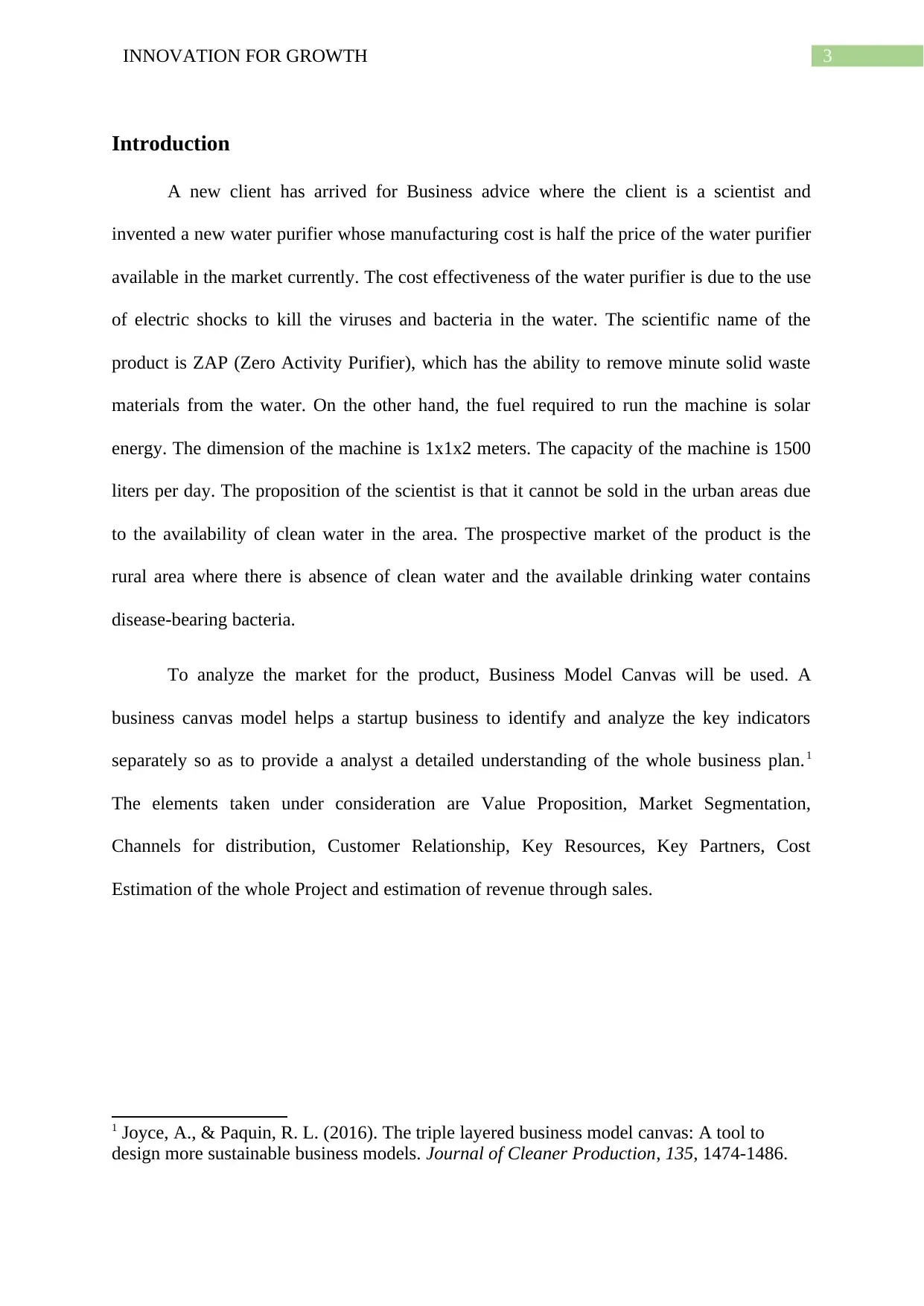
3INNOVATION FOR GROWTH
Introduction
A new client has arrived for Business advice where the client is a scientist and
invented a new water purifier whose manufacturing cost is half the price of the water purifier
available in the market currently. The cost effectiveness of the water purifier is due to the use
of electric shocks to kill the viruses and bacteria in the water. The scientific name of the
product is ZAP (Zero Activity Purifier), which has the ability to remove minute solid waste
materials from the water. On the other hand, the fuel required to run the machine is solar
energy. The dimension of the machine is 1x1x2 meters. The capacity of the machine is 1500
liters per day. The proposition of the scientist is that it cannot be sold in the urban areas due
to the availability of clean water in the area. The prospective market of the product is the
rural area where there is absence of clean water and the available drinking water contains
disease-bearing bacteria.
To analyze the market for the product, Business Model Canvas will be used. A
business canvas model helps a startup business to identify and analyze the key indicators
separately so as to provide a analyst a detailed understanding of the whole business plan.1
The elements taken under consideration are Value Proposition, Market Segmentation,
Channels for distribution, Customer Relationship, Key Resources, Key Partners, Cost
Estimation of the whole Project and estimation of revenue through sales.
1 Joyce, A., & Paquin, R. L. (2016). The triple layered business model canvas: A tool to
design more sustainable business models. Journal of Cleaner Production, 135, 1474-1486.
Introduction
A new client has arrived for Business advice where the client is a scientist and
invented a new water purifier whose manufacturing cost is half the price of the water purifier
available in the market currently. The cost effectiveness of the water purifier is due to the use
of electric shocks to kill the viruses and bacteria in the water. The scientific name of the
product is ZAP (Zero Activity Purifier), which has the ability to remove minute solid waste
materials from the water. On the other hand, the fuel required to run the machine is solar
energy. The dimension of the machine is 1x1x2 meters. The capacity of the machine is 1500
liters per day. The proposition of the scientist is that it cannot be sold in the urban areas due
to the availability of clean water in the area. The prospective market of the product is the
rural area where there is absence of clean water and the available drinking water contains
disease-bearing bacteria.
To analyze the market for the product, Business Model Canvas will be used. A
business canvas model helps a startup business to identify and analyze the key indicators
separately so as to provide a analyst a detailed understanding of the whole business plan.1
The elements taken under consideration are Value Proposition, Market Segmentation,
Channels for distribution, Customer Relationship, Key Resources, Key Partners, Cost
Estimation of the whole Project and estimation of revenue through sales.
1 Joyce, A., & Paquin, R. L. (2016). The triple layered business model canvas: A tool to
design more sustainable business models. Journal of Cleaner Production, 135, 1474-1486.
Paraphrase This Document
Need a fresh take? Get an instant paraphrase of this document with our AI Paraphraser

4INNOVATION FOR GROWTH
Value Proposition
The value proposition section focuses on the core values of the proposed business,
which are to be provided to the customers. On the other hand, it focuses on the needs of the
customer that the product or service is trying to satisfy2.
In this case, the undertaken product is water purifier. The key proposition of the
product is to provide safe drinking water to the customers. Water is the most important
product for humans so the demand for water purifiers will always be high in the market. The
secondary value, which the product will provide, is the cost of the product, which is half the
price of the available water purifiers in the market. Therefore, the demand for the product
will rise as soon as the product is made available in the market.
Market Segmentation
This area helps to analyze the target customer of the business. Market Segmentation allows
the firm to identify the buyers of the product and removes the people from the target who will
not purchase the product.
In this case of Water Purifier the market segmentation will be based on two aspects:
a) Geographic Segmentation3: Firstly, the business will operate in Australia so the
geographic segmentation is done on the basis of country. Secondly, the target area in
the country is the rural areas.
2 Osterwalder, A., Pigneur, Y., Bernarda, G., & Smith, A. (2014). Value proposition design:
How to create products and services customers want. John Wiley & Sons.
3 Weinstein, A. (2013). Handbook of market segmentation: Strategic targeting for business
and technology firms. Routledge.
Value Proposition
The value proposition section focuses on the core values of the proposed business,
which are to be provided to the customers. On the other hand, it focuses on the needs of the
customer that the product or service is trying to satisfy2.
In this case, the undertaken product is water purifier. The key proposition of the
product is to provide safe drinking water to the customers. Water is the most important
product for humans so the demand for water purifiers will always be high in the market. The
secondary value, which the product will provide, is the cost of the product, which is half the
price of the available water purifiers in the market. Therefore, the demand for the product
will rise as soon as the product is made available in the market.
Market Segmentation
This area helps to analyze the target customer of the business. Market Segmentation allows
the firm to identify the buyers of the product and removes the people from the target who will
not purchase the product.
In this case of Water Purifier the market segmentation will be based on two aspects:
a) Geographic Segmentation3: Firstly, the business will operate in Australia so the
geographic segmentation is done on the basis of country. Secondly, the target area in
the country is the rural areas.
2 Osterwalder, A., Pigneur, Y., Bernarda, G., & Smith, A. (2014). Value proposition design:
How to create products and services customers want. John Wiley & Sons.
3 Weinstein, A. (2013). Handbook of market segmentation: Strategic targeting for business
and technology firms. Routledge.

5INNOVATION FOR GROWTH
b) Behavioral Segmentation4: The next part focuses on behavioral segmentation i.e. the
purchasing pattern of the customers. Awareness about water borne diseases already
exists in the market. So, if the product is available at half the price then customers will
be attracted more towards the product than the competitors.
Channels of Distribution
This section in the Business Model Canvas helps to identify the mediums through
which the customers can be reached. On the other hand, this section helps to identify the most
suitable channel to be adopted and more to focus on and which are the channels on which
minimum focus has to be provided.
In this case, the channels of distribution will be online and offline.
Online: Firstly, the company must have a website through which the customers shall
know about the company and the details of the product. Moreover, the website must have a
section, which shall allow the customers to place orders. Payment facility such as Card,
wallet and Cash on Delivery Option must be available in the website.
Secondly, the product must be available on e-commerce websites such as Amazon, E-
bay and Alibaba so that the customers can automatically compare the process of the related
products where ZAP will enjoy an upper hand.
Offline: Secondly, the company must use traditional methods of distribution such as
the stockiest, distributors and retailers which actually will strengthen the roots of the business
in the market.
4 Haider, A. A., Zafar, A., Khalid, A., Majid, A., Abdullah, M. A., & Sarwar, M. B. (2019).
Marketing Management.
b) Behavioral Segmentation4: The next part focuses on behavioral segmentation i.e. the
purchasing pattern of the customers. Awareness about water borne diseases already
exists in the market. So, if the product is available at half the price then customers will
be attracted more towards the product than the competitors.
Channels of Distribution
This section in the Business Model Canvas helps to identify the mediums through
which the customers can be reached. On the other hand, this section helps to identify the most
suitable channel to be adopted and more to focus on and which are the channels on which
minimum focus has to be provided.
In this case, the channels of distribution will be online and offline.
Online: Firstly, the company must have a website through which the customers shall
know about the company and the details of the product. Moreover, the website must have a
section, which shall allow the customers to place orders. Payment facility such as Card,
wallet and Cash on Delivery Option must be available in the website.
Secondly, the product must be available on e-commerce websites such as Amazon, E-
bay and Alibaba so that the customers can automatically compare the process of the related
products where ZAP will enjoy an upper hand.
Offline: Secondly, the company must use traditional methods of distribution such as
the stockiest, distributors and retailers which actually will strengthen the roots of the business
in the market.
4 Haider, A. A., Zafar, A., Khalid, A., Majid, A., Abdullah, M. A., & Sarwar, M. B. (2019).
Marketing Management.
⊘ This is a preview!⊘
Do you want full access?
Subscribe today to unlock all pages.

Trusted by 1+ million students worldwide
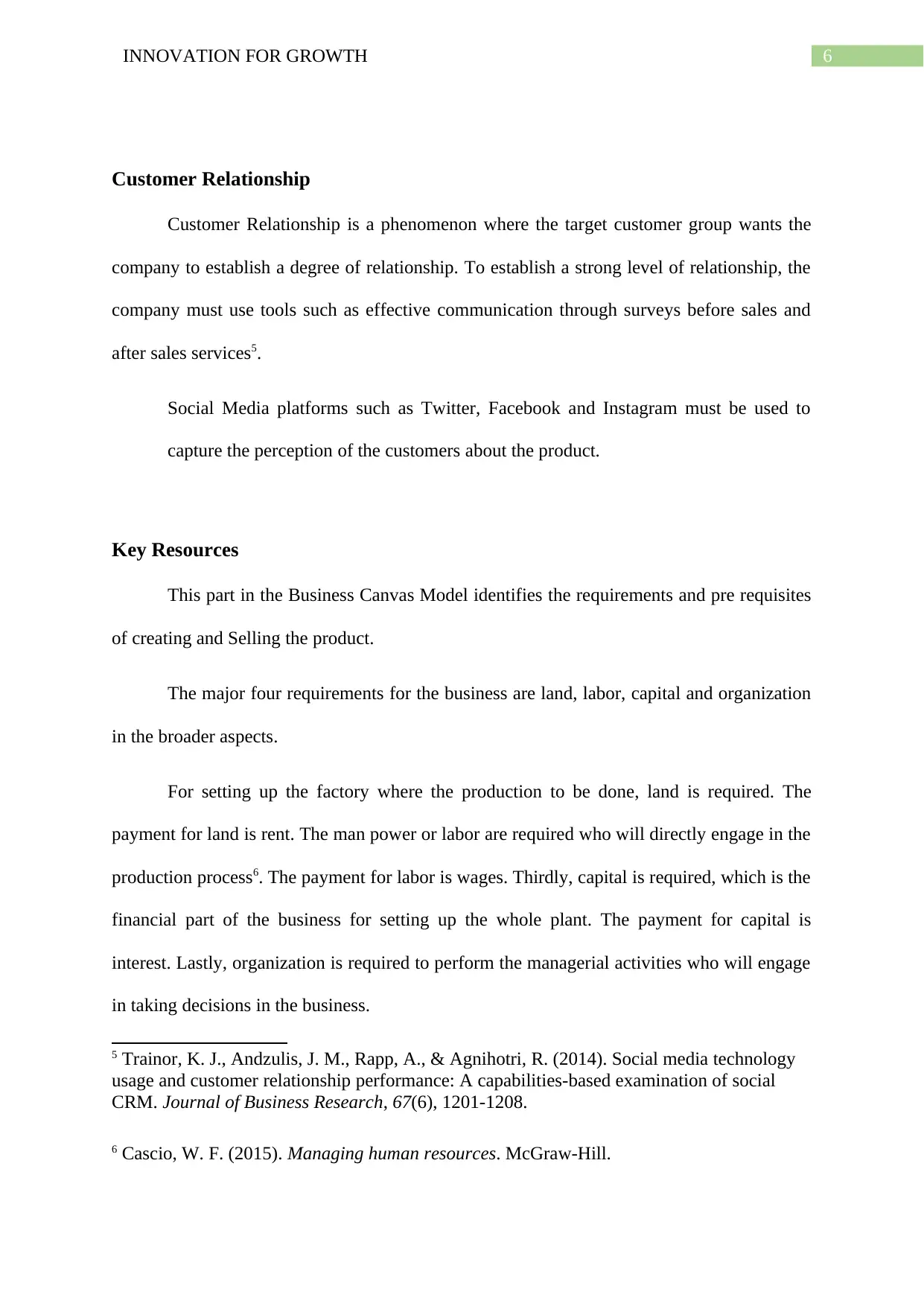
6INNOVATION FOR GROWTH
Customer Relationship
Customer Relationship is a phenomenon where the target customer group wants the
company to establish a degree of relationship. To establish a strong level of relationship, the
company must use tools such as effective communication through surveys before sales and
after sales services5.
Social Media platforms such as Twitter, Facebook and Instagram must be used to
capture the perception of the customers about the product.
Key Resources
This part in the Business Canvas Model identifies the requirements and pre requisites
of creating and Selling the product.
The major four requirements for the business are land, labor, capital and organization
in the broader aspects.
For setting up the factory where the production to be done, land is required. The
payment for land is rent. The man power or labor are required who will directly engage in the
production process6. The payment for labor is wages. Thirdly, capital is required, which is the
financial part of the business for setting up the whole plant. The payment for capital is
interest. Lastly, organization is required to perform the managerial activities who will engage
in taking decisions in the business.
5 Trainor, K. J., Andzulis, J. M., Rapp, A., & Agnihotri, R. (2014). Social media technology
usage and customer relationship performance: A capabilities-based examination of social
CRM. Journal of Business Research, 67(6), 1201-1208.
6 Cascio, W. F. (2015). Managing human resources. McGraw-Hill.
Customer Relationship
Customer Relationship is a phenomenon where the target customer group wants the
company to establish a degree of relationship. To establish a strong level of relationship, the
company must use tools such as effective communication through surveys before sales and
after sales services5.
Social Media platforms such as Twitter, Facebook and Instagram must be used to
capture the perception of the customers about the product.
Key Resources
This part in the Business Canvas Model identifies the requirements and pre requisites
of creating and Selling the product.
The major four requirements for the business are land, labor, capital and organization
in the broader aspects.
For setting up the factory where the production to be done, land is required. The
payment for land is rent. The man power or labor are required who will directly engage in the
production process6. The payment for labor is wages. Thirdly, capital is required, which is the
financial part of the business for setting up the whole plant. The payment for capital is
interest. Lastly, organization is required to perform the managerial activities who will engage
in taking decisions in the business.
5 Trainor, K. J., Andzulis, J. M., Rapp, A., & Agnihotri, R. (2014). Social media technology
usage and customer relationship performance: A capabilities-based examination of social
CRM. Journal of Business Research, 67(6), 1201-1208.
6 Cascio, W. F. (2015). Managing human resources. McGraw-Hill.
Paraphrase This Document
Need a fresh take? Get an instant paraphrase of this document with our AI Paraphraser
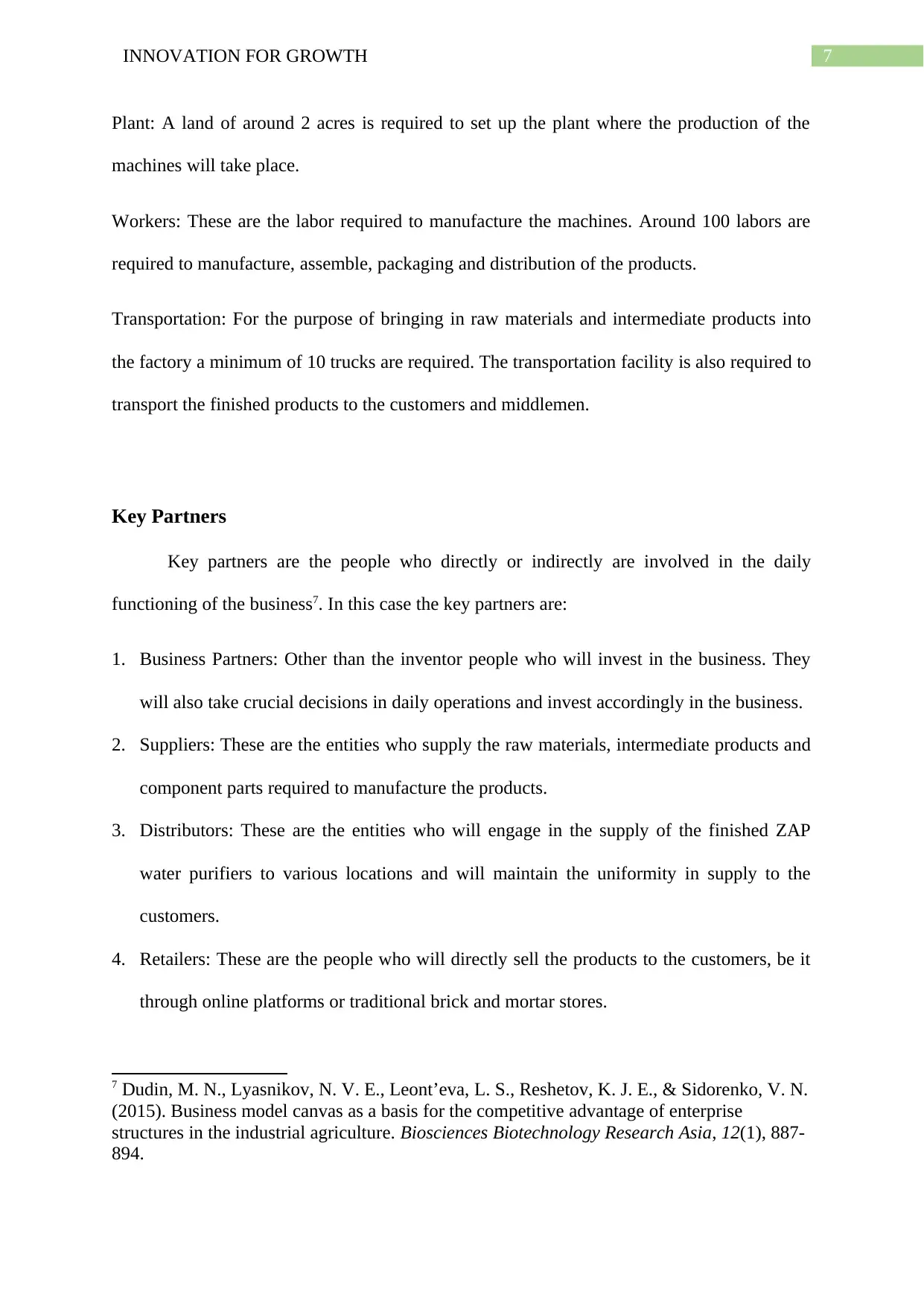
7INNOVATION FOR GROWTH
Plant: A land of around 2 acres is required to set up the plant where the production of the
machines will take place.
Workers: These are the labor required to manufacture the machines. Around 100 labors are
required to manufacture, assemble, packaging and distribution of the products.
Transportation: For the purpose of bringing in raw materials and intermediate products into
the factory a minimum of 10 trucks are required. The transportation facility is also required to
transport the finished products to the customers and middlemen.
Key Partners
Key partners are the people who directly or indirectly are involved in the daily
functioning of the business7. In this case the key partners are:
1. Business Partners: Other than the inventor people who will invest in the business. They
will also take crucial decisions in daily operations and invest accordingly in the business.
2. Suppliers: These are the entities who supply the raw materials, intermediate products and
component parts required to manufacture the products.
3. Distributors: These are the entities who will engage in the supply of the finished ZAP
water purifiers to various locations and will maintain the uniformity in supply to the
customers.
4. Retailers: These are the people who will directly sell the products to the customers, be it
through online platforms or traditional brick and mortar stores.
7 Dudin, M. N., Lyasnikov, N. V. E., Leont’eva, L. S., Reshetov, K. J. E., & Sidorenko, V. N.
(2015). Business model canvas as a basis for the competitive advantage of enterprise
structures in the industrial agriculture. Biosciences Biotechnology Research Asia, 12(1), 887-
894.
Plant: A land of around 2 acres is required to set up the plant where the production of the
machines will take place.
Workers: These are the labor required to manufacture the machines. Around 100 labors are
required to manufacture, assemble, packaging and distribution of the products.
Transportation: For the purpose of bringing in raw materials and intermediate products into
the factory a minimum of 10 trucks are required. The transportation facility is also required to
transport the finished products to the customers and middlemen.
Key Partners
Key partners are the people who directly or indirectly are involved in the daily
functioning of the business7. In this case the key partners are:
1. Business Partners: Other than the inventor people who will invest in the business. They
will also take crucial decisions in daily operations and invest accordingly in the business.
2. Suppliers: These are the entities who supply the raw materials, intermediate products and
component parts required to manufacture the products.
3. Distributors: These are the entities who will engage in the supply of the finished ZAP
water purifiers to various locations and will maintain the uniformity in supply to the
customers.
4. Retailers: These are the people who will directly sell the products to the customers, be it
through online platforms or traditional brick and mortar stores.
7 Dudin, M. N., Lyasnikov, N. V. E., Leont’eva, L. S., Reshetov, K. J. E., & Sidorenko, V. N.
(2015). Business model canvas as a basis for the competitive advantage of enterprise
structures in the industrial agriculture. Biosciences Biotechnology Research Asia, 12(1), 887-
894.
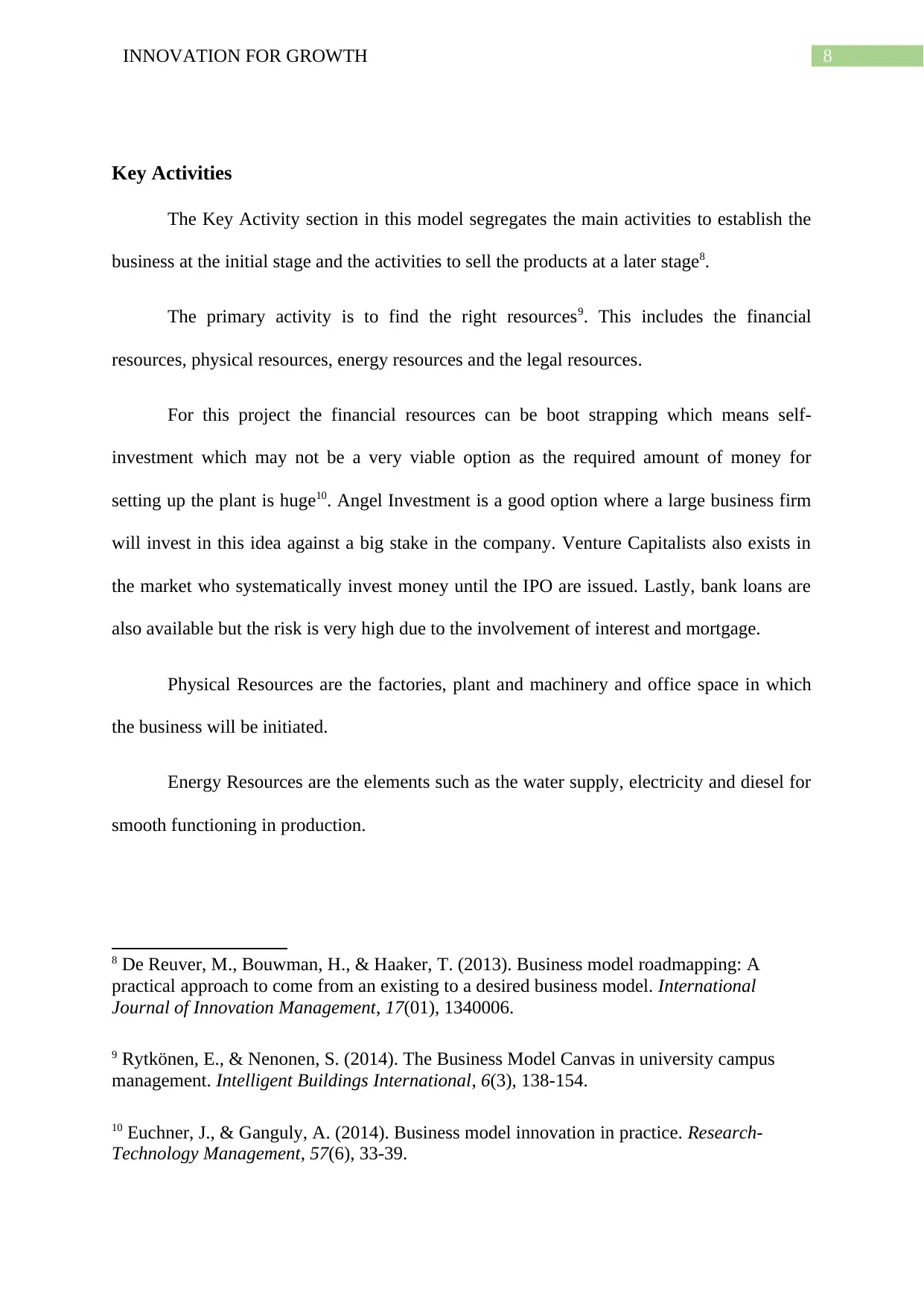
8INNOVATION FOR GROWTH
Key Activities
The Key Activity section in this model segregates the main activities to establish the
business at the initial stage and the activities to sell the products at a later stage8.
The primary activity is to find the right resources9. This includes the financial
resources, physical resources, energy resources and the legal resources.
For this project the financial resources can be boot strapping which means self-
investment which may not be a very viable option as the required amount of money for
setting up the plant is huge10. Angel Investment is a good option where a large business firm
will invest in this idea against a big stake in the company. Venture Capitalists also exists in
the market who systematically invest money until the IPO are issued. Lastly, bank loans are
also available but the risk is very high due to the involvement of interest and mortgage.
Physical Resources are the factories, plant and machinery and office space in which
the business will be initiated.
Energy Resources are the elements such as the water supply, electricity and diesel for
smooth functioning in production.
8 De Reuver, M., Bouwman, H., & Haaker, T. (2013). Business model roadmapping: A
practical approach to come from an existing to a desired business model. International
Journal of Innovation Management, 17(01), 1340006.
9 Rytkönen, E., & Nenonen, S. (2014). The Business Model Canvas in university campus
management. Intelligent Buildings International, 6(3), 138-154.
10 Euchner, J., & Ganguly, A. (2014). Business model innovation in practice. Research-
Technology Management, 57(6), 33-39.
Key Activities
The Key Activity section in this model segregates the main activities to establish the
business at the initial stage and the activities to sell the products at a later stage8.
The primary activity is to find the right resources9. This includes the financial
resources, physical resources, energy resources and the legal resources.
For this project the financial resources can be boot strapping which means self-
investment which may not be a very viable option as the required amount of money for
setting up the plant is huge10. Angel Investment is a good option where a large business firm
will invest in this idea against a big stake in the company. Venture Capitalists also exists in
the market who systematically invest money until the IPO are issued. Lastly, bank loans are
also available but the risk is very high due to the involvement of interest and mortgage.
Physical Resources are the factories, plant and machinery and office space in which
the business will be initiated.
Energy Resources are the elements such as the water supply, electricity and diesel for
smooth functioning in production.
8 De Reuver, M., Bouwman, H., & Haaker, T. (2013). Business model roadmapping: A
practical approach to come from an existing to a desired business model. International
Journal of Innovation Management, 17(01), 1340006.
9 Rytkönen, E., & Nenonen, S. (2014). The Business Model Canvas in university campus
management. Intelligent Buildings International, 6(3), 138-154.
10 Euchner, J., & Ganguly, A. (2014). Business model innovation in practice. Research-
Technology Management, 57(6), 33-39.
⊘ This is a preview!⊘
Do you want full access?
Subscribe today to unlock all pages.

Trusted by 1+ million students worldwide

9INNOVATION FOR GROWTH
Legal Resources includes licenses, permits and registrations for setting up the plant
and perform daily operations. The absence of any legal permission may result in sudden stop
in the whole business functioning.
Revenues
The revenue streams are the sources through which the company will make money.
The sources of revenue for ZAP water purifiers are through online transactions i.e. through
sales from e commerce and website11. The second source of revenue is through sales from
conventional distribution channel. Lastly, the revenue will be generated from the government
if the product can be installed at government offices and sites if they accept tenders12.
Cost
This part of the Business Model Canvas deals with the investment and costs related for
setting up the business initially, operating cost of the business and cost incurred to sell the
product13. The various magnitudes are:
1. Fixed Cost: These are the cost, which are required only once to establish the physical
unit of the business. These are:
11 Toro-Jarrín, M. A., Ponce-Jaramillo, I. E., & Güemes-Castorena, D. (2016). Methodology
for the of building process integration of Business Model Canvas and Technological
Roadmap. Technological Forecasting and Social Change, 110, 213-225.
12 Preece, S. B. (2015). Acquiring Start‐Up Funding for New Arts Organizations. Nonprofit
management and leadership, 25(4), 463-474.
13 Yu, M. M., Chen, L. H., & Hsiao, B. (2016). A fixed cost allocation based on the two-stage
network data envelopment approach. Journal of Business Research, 69(5), 1817-1822.
Legal Resources includes licenses, permits and registrations for setting up the plant
and perform daily operations. The absence of any legal permission may result in sudden stop
in the whole business functioning.
Revenues
The revenue streams are the sources through which the company will make money.
The sources of revenue for ZAP water purifiers are through online transactions i.e. through
sales from e commerce and website11. The second source of revenue is through sales from
conventional distribution channel. Lastly, the revenue will be generated from the government
if the product can be installed at government offices and sites if they accept tenders12.
Cost
This part of the Business Model Canvas deals with the investment and costs related for
setting up the business initially, operating cost of the business and cost incurred to sell the
product13. The various magnitudes are:
1. Fixed Cost: These are the cost, which are required only once to establish the physical
unit of the business. These are:
11 Toro-Jarrín, M. A., Ponce-Jaramillo, I. E., & Güemes-Castorena, D. (2016). Methodology
for the of building process integration of Business Model Canvas and Technological
Roadmap. Technological Forecasting and Social Change, 110, 213-225.
12 Preece, S. B. (2015). Acquiring Start‐Up Funding for New Arts Organizations. Nonprofit
management and leadership, 25(4), 463-474.
13 Yu, M. M., Chen, L. H., & Hsiao, B. (2016). A fixed cost allocation based on the two-stage
network data envelopment approach. Journal of Business Research, 69(5), 1817-1822.
Paraphrase This Document
Need a fresh take? Get an instant paraphrase of this document with our AI Paraphraser
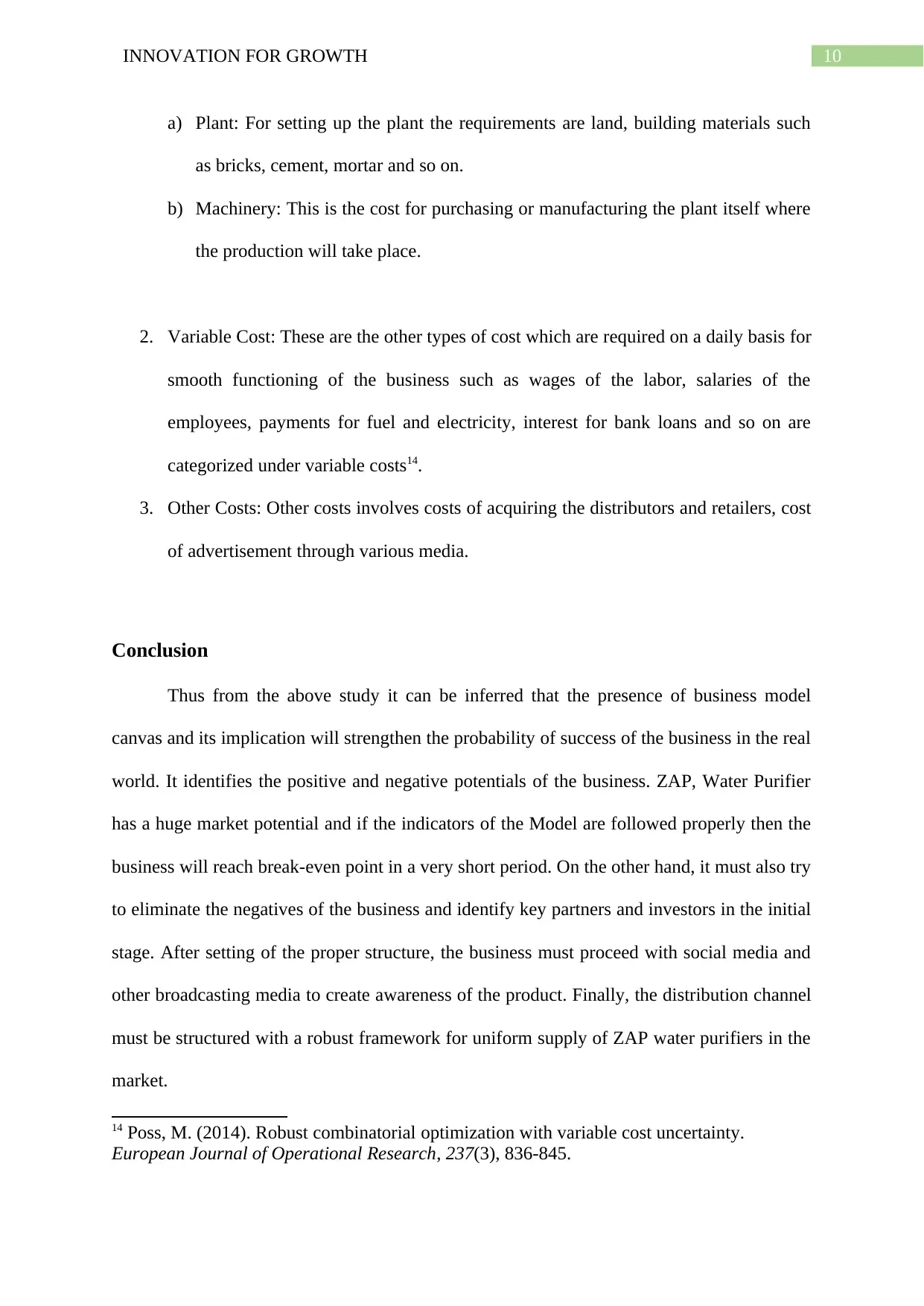
10INNOVATION FOR GROWTH
a) Plant: For setting up the plant the requirements are land, building materials such
as bricks, cement, mortar and so on.
b) Machinery: This is the cost for purchasing or manufacturing the plant itself where
the production will take place.
2. Variable Cost: These are the other types of cost which are required on a daily basis for
smooth functioning of the business such as wages of the labor, salaries of the
employees, payments for fuel and electricity, interest for bank loans and so on are
categorized under variable costs14.
3. Other Costs: Other costs involves costs of acquiring the distributors and retailers, cost
of advertisement through various media.
Conclusion
Thus from the above study it can be inferred that the presence of business model
canvas and its implication will strengthen the probability of success of the business in the real
world. It identifies the positive and negative potentials of the business. ZAP, Water Purifier
has a huge market potential and if the indicators of the Model are followed properly then the
business will reach break-even point in a very short period. On the other hand, it must also try
to eliminate the negatives of the business and identify key partners and investors in the initial
stage. After setting of the proper structure, the business must proceed with social media and
other broadcasting media to create awareness of the product. Finally, the distribution channel
must be structured with a robust framework for uniform supply of ZAP water purifiers in the
market.
14 Poss, M. (2014). Robust combinatorial optimization with variable cost uncertainty.
European Journal of Operational Research, 237(3), 836-845.
a) Plant: For setting up the plant the requirements are land, building materials such
as bricks, cement, mortar and so on.
b) Machinery: This is the cost for purchasing or manufacturing the plant itself where
the production will take place.
2. Variable Cost: These are the other types of cost which are required on a daily basis for
smooth functioning of the business such as wages of the labor, salaries of the
employees, payments for fuel and electricity, interest for bank loans and so on are
categorized under variable costs14.
3. Other Costs: Other costs involves costs of acquiring the distributors and retailers, cost
of advertisement through various media.
Conclusion
Thus from the above study it can be inferred that the presence of business model
canvas and its implication will strengthen the probability of success of the business in the real
world. It identifies the positive and negative potentials of the business. ZAP, Water Purifier
has a huge market potential and if the indicators of the Model are followed properly then the
business will reach break-even point in a very short period. On the other hand, it must also try
to eliminate the negatives of the business and identify key partners and investors in the initial
stage. After setting of the proper structure, the business must proceed with social media and
other broadcasting media to create awareness of the product. Finally, the distribution channel
must be structured with a robust framework for uniform supply of ZAP water purifiers in the
market.
14 Poss, M. (2014). Robust combinatorial optimization with variable cost uncertainty.
European Journal of Operational Research, 237(3), 836-845.
1 out of 11
Related Documents
Your All-in-One AI-Powered Toolkit for Academic Success.
+13062052269
info@desklib.com
Available 24*7 on WhatsApp / Email
![[object Object]](/_next/static/media/star-bottom.7253800d.svg)
Unlock your academic potential
Copyright © 2020–2025 A2Z Services. All Rights Reserved. Developed and managed by ZUCOL.





